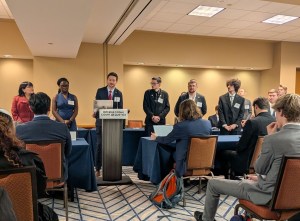
ICJ: Treaties and Maps: Cambodia v. Thailand

By: Kylie Edmundson
Member States Cambodia and Thailand arrived at the International Court of Justice to discuss the case, Temple of Preah Vihear (Cambodia v. Thailand), regarding an ancient Hindu temple. Significant historical ties to the temple are claimed by both Cambodia as well as Thailand, although disputes have been raised over the ownership of the temple itself and the land surrounding. Both Member States were present to represent and defend their viewpoints, as well as rebut points made by the opposing Member State.
Advocates of Cambodia claim that the temple resides in their land according to the “Annex I Map” created by France in 1907. They claim that this map proves Thailand accepted Cambodia’s ownership of the temple due to Thailand not contesting the map for decades. Advocate Zack Nosky of Cambodia says, “We specifically ask for the removal of Thai troops from Preah Vihear, the acknowledgement that it is indeed sovereign to Cambodia and the return of any artifacts or materials that were taken from the temple during the occupation period.” Cambodia pressed for the importance of these requests to be addressed in the upcoming ruling.
Thailand followed Cambodia in arguing their case to the Court. They cited the Franco–Siamese Treaty of 1904 as proof of their ownership over the temple. This treaty has previously noted the border of Thailand and Cambodia on a watershed line, which puts the Preah Vihear in Thai territory. They argue that the Annex I Map cannot supersede the Franco–Siamese Treaty as maps should not be able to override previous treaties. Due to this they argue that they were under the understanding that the Preah Vihear was still in Thai territory. While this is one of their main arguments, they also spoke heavily on the topic of the jurisdiction of the Court. Advocate Diego Gómez-Zamora of Thailand said, “We contend that the court has no jurisdiction to hear this case (…) we have never explicitly provided compulsory jurisdiction to the Court.” Thailand focused heavily on both the map’s validity in comparison to the Franco–Siamese Treaty, as well as the Court and their level of jurisdiction.
Cambodia rebutted Thailand’s claims to being unaware of a border change since the Franco–Siamese Treaty in 1904. One of their main points focuses on an event where Prince Damrong of Thailand thanked French troops after they escorted him through the area, while the region had been flying French flags. At the time Cambodia was a French protectorate. Cambodia raised the question that if the Thai government believed the land belonged to them, why wouldn’t they file a letter of protest when seeing French flags and troops in the area?
Advocates of Thailand responded to Cambodia by again pushing the point that the Franco–Siamese Treaty is unable to be overruled by a map, as well as expanding on the importance of the temple to Thai citizens and not just Cambodians. Advocate Gómez-Zamora of Thailand said, “Yes, Cambodia has cultural ties to it, but so do the Thai people, and I think it’s important to recognize the precious value that it has to Thai culture…”
The courts met the following evening to read the majority opinion. The Court concurred with Cambodia, deciding that Annex I Map is legally binding, and the temple and surrounding territory falls under Cambodian jurisdiction. The Court also recommends all artifacts and materials that were removed should be returned to Cambodia to promote reconciliation. They also encourage Thailand to remove any personnel surrounding the temple. A dissenting opinion consisted of two justices, and focused on the Court’s jurisdiction over Thailand. The dissenting opinion believes that each Member State has authority to withdraw from jurisdiction of the court, and that Thailand had withdrawn their jurisdiction rightfully. They do however approve of recommendations and measures by the majority opinion.
Keep Up With The Accords
More to read
The AMUN Accords is a premier resource for fact-based Model United Nations simulations. We are always looking for new contributors. Want to write for the AMUN Accords? Check out out the submission guidelines and then get in touch!
